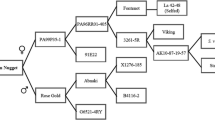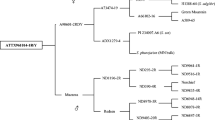Abstract
Bannock Russet, a late-maturing, long russet potato cultivar, was released in 1999 by the USDA-ARS and the experiment stations of Idaho, Oregon, and Washington. It is suitable for processing into french fries and other frozen products. Its attractive russeted skin and excellent culinary qualities also make it suitable for fresh market. Bannock Russet, in comparisons with Russet Burbank, has consistently produced greater U.S. No. 1 yields in trials conducted throughout southern Idaho. In other western trial sites, total yields of Bannock Russet have been comparable to or smaller than that of Russet Burbank, but its percentage of undersize and cull potatoes is consistently less. Bannock Russet is resistant to potato virus Y (PVY), Verticillium wilt, common scab, and leafroll net necrosis. It also has moderate resistance to early blight (foliar and tuber) andErwinia soft rot. With respect to other potato diseases/disorders, Bannock Russet’s level of susceptibility is similar to that of Russet Burbank; the exception being shatter bruise, with Bannock Russet displaying a greater susceptibility. Cultural management guidelines have been developed to minimize shatter bruise in Bannock Russet. Bannock Russet’s multiple disease resistances coupled with its low nitrogen requirement, make it a low-input cultivar that could significantly reduce growers’ production costs.
Resumen
Bannock Russet, un cultivar de papa de maduración tardía, alargado y rojizo, fue liberado en 1999 por USDA-ARS y las estaciones experimentales de Idaho, Oregón y Washington. Es adecuado para el procesamiento de papas fritas a la francesa y otros productos congelados. Su atractiva piel rojiza y sus excelentes cualidades culinarias lo hacen igualmente adecuado para el mercado fresco. En los ensayos realizados en todo el sur de Idaho, en comparación con Russet Burbank, la variedad Bannock Russet sistemáticamente ha obtenido el primer lugar en rendimiento de los Estados Unidos. En otros campos de prueba del oeste, los rendimientos totales de Bannock Russet han sido equivalentes o más bajos que los de Russet Burbank, pero el porcentaje de papas con tamaño insuficiente y de desecho es notablemente menor. Bannock Russet es resistente al virus Y de la papa (PVY), a la verticilosis, sarna común y a la necrosis reticulada de enrollamiento de la papa. También posee resistencia moderada al tizón temprano (foliar y tubérculo) y a la pudrición blanda por Erwinia. Respecto a otras enfermedades o transtornos de la papa, el nivel de susceptibilidad es similar al de Russet Burbank, con excepción de que Bannock Russet es más proclive a que se produzcan magulladuras con rotura de la piel del tubérculo. Las pautas de manejo cultural han sido desarrolladas para reducir al mínimo dichas magulladuras en Bannock Russet. La múltiple resistencia a enfermedades de este cultivar se aúna a su bajo requerimiento de nitrógeno, que convierte a Bannock Russet en un cultivar de baja inversión que puede reducir significativamente los costos de productión de los agricultores.
Similar content being viewed by others
Literature Cited
Corsini, D., and J.J. Pavek. 1986. Fusarium dry-rot resistant potato germplasm. Am Potato J 63:629–638.
Corsini, D.L., J.J. Pavek, and J.R. Davis. 1988. Verticillium wilt resistance in non-cultivated tuber-bearingSolanum species. Plant Dis 75:148–151.
Corsini, D.L., J.J. Pavek, M.W. Martin, and C.R. Brown. 1994. Potato germplasm with combined resistance to leafroll virus and viruses X and Y. Am Potato J 71:377–385.
Hoyman, W.G., and R.C. Holland. 1974. Nooksack: A russet potato adapted to northwestern Washington. Am Potato J 51:99–103.
Inglis, D.A., D.A. Johnson, D.E. Legard, W.E. Pry, and P.B. Hamm. 1996. Relative resistance of potato clones in response to new and old populations ofPhytophthora infestans. Plant Dis 80:575–578.
Johansen, R.H., E.P. Lana, and A.P. Benson. 1963. Viking, a new, highyielding red-skinned potato variety. Am Potato J 41:253–255.
Johansen, R.H. 1965. Norgold Russet, a new, early maturing potato variety with good type and scab resistance. Am Potato J 42:201–204.
Love, S.L., W.H. Bohl, D. Corsini, J.C. Stark, and N. Olsen. In press. Cultural Management of Bannock Russet Potatoes. ID Ag. Exp. Station Current Information Series No.
Pavek, J.J., D.R. Douglas, H.C. McKay, and R.E. Ohms. 1973. Targhee: An oblong russet potato variety with attractive tubers and high resistance to common scab. Am Potato J 50:293–296.
Author information
Authors and Affiliations
Corresponding author
Rights and permissions
About this article
Cite this article
Novy, R.G., Corsini, D.L., Love, S.L. et al. Bannock russet: A dual-purpose, russet potato cultivar with high U. S. No. 1 yield and multiple disease resistances. Am. J. Pot Res 79, 147–153 (2002). https://doi.org/10.1007/BF02881524
Accepted:
Issue Date:
DOI: https://doi.org/10.1007/BF02881524




